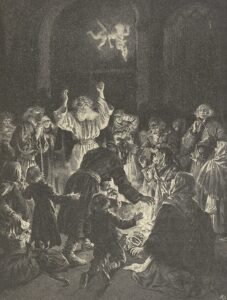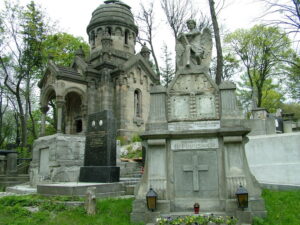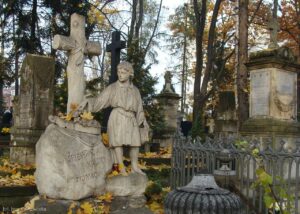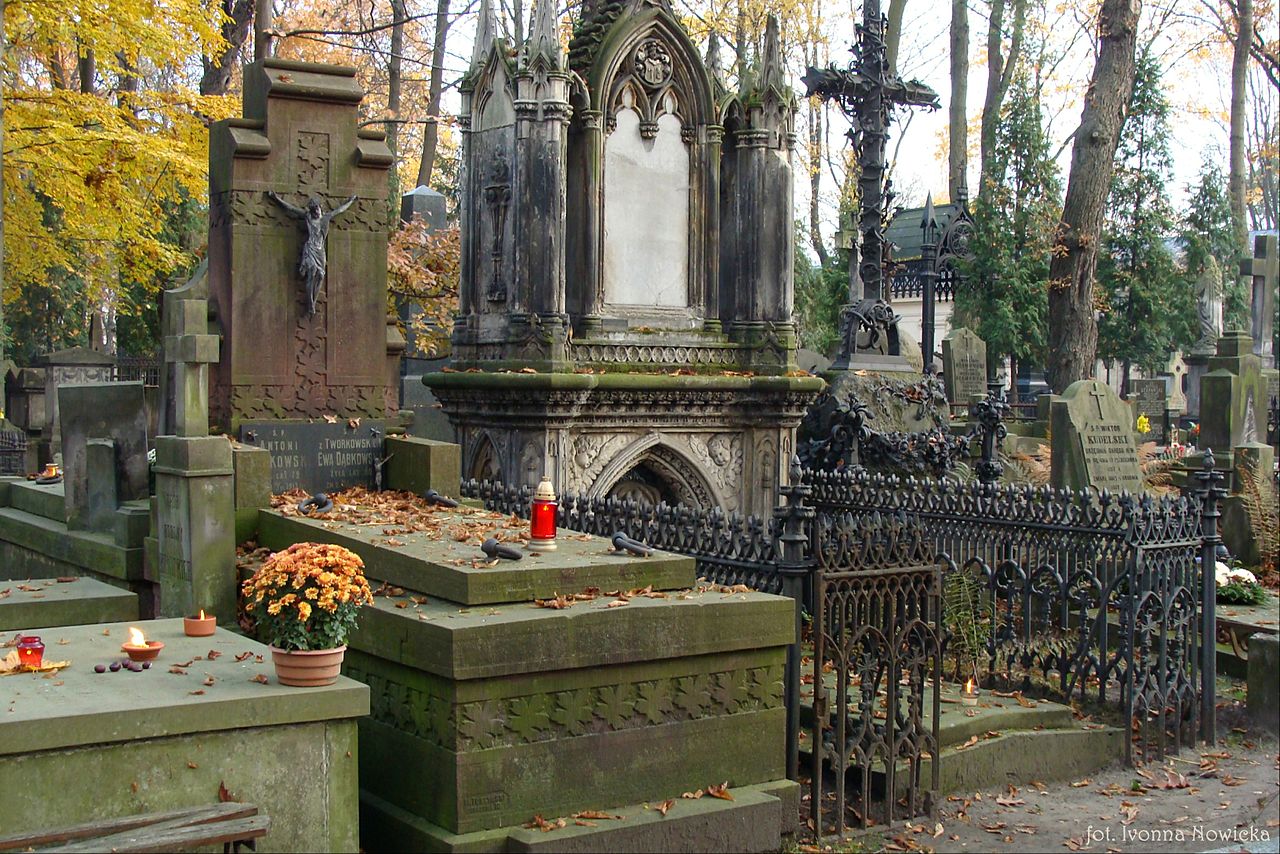Withal, do not forget the deade: whatever your stacyon, take this dae to remember your father’s soule, and your mother’s, and the soules of your compeers.
polishhistory: Dr. Grodziska, the dead are revered across all cultures. What is the origin of the traditions and customs underlying All Saints’ Day in our culture?
Dr. Karolina Grodziska: One would need to begin with the Celtic feast of Samhain which, for the Celts, marked the end of summer, the end of the harvest period and, on a symbolic level, the end of the year and the beginning of another. The dates for this festivity, the highlight of the Celtic calendar, were none other than 31 October and 1 November.
Did the feast have anything to do with the cult of the dead?
It certainly did. It is true that we do not know that much about Samhain: written records are few. But we do know the Celts believed that on the night from 31 October to 1 November the dead revisit places where they used to live, wishing to enter what were once their homes, returning to villages that used to be theirs. The Celts put out fireplaces to make their homes appear unwelcoming and prevent ghosts from “settling in.” At the same time, people were keen to show their kindness and goodness to the dead, so they placed some food in front of their homes: a snack for the visitors. Priests oversaw collective rituals: they lit up fires and offerings were made. One interesting point is that during the feast the Celts took care to be poorly dressed, posed as vagrants and destitute people – all to prevent a spirit from entering their bodies: after all, what ghost would want to enter the body of a poor vagrant…

Such dressing up can bring present-day Halloween to mind.
Yes, absolutely. In some ways, Halloween, which sparks controversy in some circles [in Poland], has its roots in these Celtic rituals. Obviously, the great pagan feast of Samhain lived on after Christianity had been introduced: in France, as well as in England, Ireland and what is today German territory. The Catholic Church could hardly ignore it, and we know the Church was very adept at taking over both sites of pagan shrines – quite simply, churches, chapels and convents were built on these spots – and pagan time, the calendar of pagan feasts. Samhain is an excellent example of this.
Why “All Saints’ Day”?
On this day, the Church remembers all Christians who attained salvation: in other words, “saints.” It follows that, from the earliest days, it had been a joyful, happy feast in Church liturgy: people prayed, and, as one Catholic encyclopaedia put it, their prayers “showed God’s power and His love for angels and people; reminded those present that all salvation originates from God, and in Him rests the happiness of all creation.” On the festive day, priests celebrated Mass in elaborate robes, and fasts were abolished even if, in theory, the feast fell on a fasting day of the week. A celebration on 1 November was first mentioned in Church records in 741. All Saints’ Day was, as it were, officially established by Pope John XI in 935 and, in 1475, Pope Sixtus IV declared it a mandatory feast for all believers. These three dates are the highlights in the history of the feast. In choosing that particular date, 1 November, the Church clearly had the earlier Celtic rituals in mind.

These “pagan” traits survived until the early 19th century: suffice it to mention Forefathers’ Eve by Adam Mickiewicz [Dziady, Poland’s foremost Romantic drama].
That is right. But first, let’s move on to All Souls’ Day, so that we can clarify things and set them straight: the Benedictine convent at Cluny had been pivotal for the Catholic Church and medieval European culture. A very interesting person and present-day saint deserves a mention here: the fifth abbot of Cluny, called Odilo. By the way, Odilo became a saint but his name barely resonates with our culture – in Poland, the cult of St. Odilo in nonexistent. In 998 – 1,018 years ago! – Odilo introduced a decree which was in force in his convent and, later, in all Benedictine convents. The document, known as “Statutum pro Defunctis,” stipulated that on 2 November the dead should have a special place in the prayers of the people. This hypothesis about the origins of All Souls’ Day is compatible with views that are widely accepted in somewhat older writings on the subject. Contemporary scholars specializing in the field, such as Father Prof. Alfons Labudda, argued that the feast of 2 November itself had been taking shape even earlier: all Abbot Odilo did was to sanction the existing custom. Regardless of which hypothesis is true, the network of Cluniac, Benedictine convents was developing by leaps and bounds – with the result that the Church feast spread across Europe.
Did this include Poland?
As far as Polish territory is concerned, the oldest written record of All Souls’ Day being celebrated in Poland is a 12th-century calendar issued by the Cistercian convent in Ląd in the Wielkopolska region.
A hundred years later – that is, in the 13th century – All Souls’ Day was celebrated “in our country” by a far greater number of religious orders, including the Dominican Friars, the Norbertine and Clarissian nuns, as well as secular clergy in Kraków, Poznań and Gniezno. And so, in Catholic liturgy, we have two feasts immediately following one another: 1 November, the joyous All Saints’ Day, and 2 November, the Feast of the Dead or All Souls’ Day. In terms of popular consciousness and of rituals the latter feast was far more important.

It was accompanied by customs that appear obsolete today.
Mourning processions were taking place, leading from the church to the cemetery – in those days, the cemetery was usually adjacent to the church. Another very interesting tradition, known as wypominki, or prayer for all the faithful departed, was developing during that time; indeed, it is with us to this day. Crucially, this was the earliest form of church prayer in Polish! Wypominki were being practiced in Poland as early as in the 10th century. The oldest written record of this type of prayer – an excerpt from a sermon calling for prayer for the dead – dates from the 15th century:
Withal, do not forget the deade: whatever your stacyon, take this dae to remember your father’s soule, and your mother’s, and the soules of your compeers. Especially I recommend unto your gracefulle prayers those soules whose bodies lieth here in this house, that is, the church, and in the cemiterie. Withal, I implore you for one Hail Mary for these soules whose bodies perished in combat and at sea. Withal I ask for one Hail Mary for these hollowed soules that suffer in purgatorye and have no succour whatsoever, but look unto us and call: haue mersye, haue mersye upon us!
Alms were handed out very generously on that day, All Souls’ Day: tradition had it that beggars who sat in front of the church (known as dziady, or paupers) had to be invited to people’s homes for a meal, rather than simply given money. This is where Adam Mickiewicz’s impressionistic take on the feast of Forefathers’ Eve, which you mentioned before, comes in.

At the same time, All Saints’ Day and All Souls’ Day traditions were subject to constant evolution.
That’s right. The fundamental change took place in the late 18th century. Up to that time, cemeteries were usually located adjacent to churches, within the strict town center or the center of the village. As science developed, in the late 18th century people began to realize that situating a cemetery in such proximity to a town or village edifice constitutes a sanitary and epidemiological hazard. So the Enlightenment forced people to locate cemeteries at a greater distance from city centers, to what had up to then been the outskirts of urban areas and villages. Just to give you a few dates, as an example: the Łyczakowski Cemetery [in Lwów] was founded in 1784, Powązkowski [in Warsaw] in 1792 and Rakowicki [in Kraków] in 1803. It followed that the traditions and customs related to All Souls’ Day had to change, because the cemetery which was supposed to be the destination of the procession was suddenly located at a considerable distance, sometimes a few kilometres away from the church where Mass was celebrated. And outside, it’s autumn and bad weather – add to that the woeful state of roads at the time: they were muddy, and very few people had carriages. And so, gradually, the customs change: increasingly, All Souls’ Day is not about a procession to and around the cemetery, but about visiting graves independently, as a family. These visits could take place throughout All Souls’ Day.
Just like today then. What about candles, lamps and flowers?
Maria Estreicherówna, the excellent Kraków-based memoirist, gave the following description of All Souls’ Day in mid 19th-century Kraków:
People were heading to the cemetery in droves – predominantly, one must add, to pray at the graves of their next of kin rather than out of curiosity: at the time, there was not as much to look at as there is today. For the custom of lavishly adorning graves was only introduced by the Germans and their graves were few and far between.

I’ll add another quote – this time, from 1864. Jan Kanty Turski, today a forgotten man of letters, was rather scathing about this new custom of adorning graves:
Nowadays, we dress graves as if they were gardens; and one could even have a beer at a grave, for want of anything better. We light many candles by the tombs – and this is the very reason why we only remember our dead and spare a thought for them when in the garden above their graves. Beyond the cemetery, the ghost of the departed ought not to trouble us, and God forbid it should interfere with our lives, rummaging indiscreetly in our conscience, which is as clean-swept as the earth around the grave in the cemetery.
This is a very interesting statement, made immediately after the collapse of the January Uprising [by 1864], in which many of the young author’s friends and colleagues had been killed. I think the bitterness with which he speaks of the “rich adornment of graves” – a substitute for a more profound reflection, which could result in “the conscience being moved” – has its roots precisely in the sorrow for the collapse of the insurrection. The work of Oskar Kolberg includes interesting descriptions of All Souls’ Day celebrations. In The Cracovian Province [Krakowskie], a book he published in 1875 [from his multivolume series concerning various folk traditions around Poland], Kolberg states that in cities, the celebrations are thoroughly Christian in character. Early in the day, Mass is said in a church dressed with pall, for the souls doing their penance in purgatory. A catafalque is placed in the middle of the church. A procession to the cemetery takes place around noon, followed by another Mass, after which people visit their family graves. Wreaths of xeranthemum and periwinkle are laid on the graves, and lamps and cressets are lit.
Almost simultaneously, the Kraków newspaper Time [Czas] describes the custom of lighting candles on graves as “brought over from the West not long ago.” This was what it had been like in Kraków.

And in the countryside?
Going to the priest to ask him for wypominki remained an important part of the celebrations: in mid 19th century, the fixed fee for praying for the dead was three cents “per soul.” A significant sum of money – several Rhineland zloty – was involved if wypominki were ordered for the length of the year. One might add that people universally believed that on All Souls’ Day,
purgatorial souls visit their relatives and friends, walk around the village and come to church for Mass, which is likewise celebrated by deceased priests. The living should not enter the church during that time.
This belief had been so strong that, in some villages, churches were left open on the night of the first to the second of November so that roaming souls could come inside. People were convinced that ghosts of departed priests celebrated Mass for their deceased parishioners. Obviously, there was another quite superstitious fear involved in this: the living tried not to leave their homes on that night. Leaving some food for the souls beyond the threshold was a custom that stemmed from the countryside. And here we complete our circle, as it were, and return to the Celtic feast of Samhain.
Dr. Karolina Grodziska is a historian, director of the Polska Akademia Umiejętności [Polish Academy of Learning] and the library of the Polska Akademia Nauk [Polish Academy of Sciences] in Kraków. She has published widely on the history of Kraków, and is the author of numerous monographs on Polish necropolises.
Interviewer: Emil Marat
Translation: Alicja Rose & Jessica Sirotin





